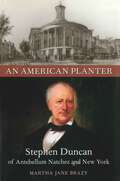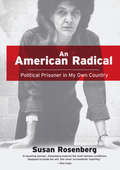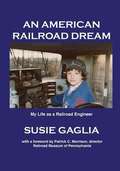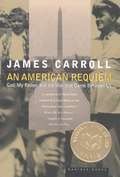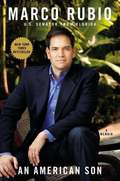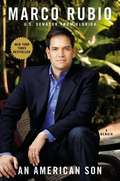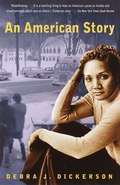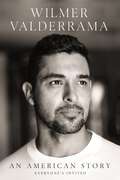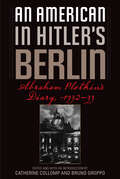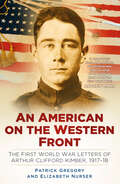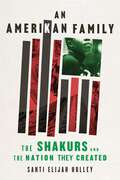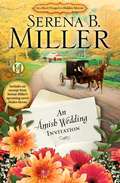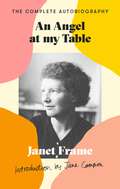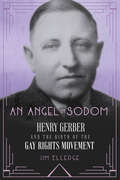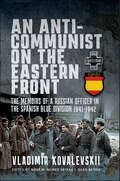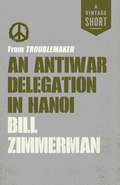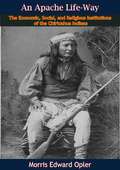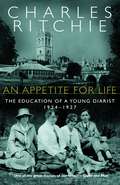- Table View
- List View
An American Planter: Stephen Duncan of Antebellum Natchez and New York (Southern Biography Series)
by Martha Jane BrazyExtraordinarily wealthy and influential, Stephen Duncan (1787-1867) was a landowner, slaveholder, and financier with a remarkable array of social, economic, and political contacts in pre-Civil War America. In this, the first biography of Duncan, Martha Jane Brazy offers a compelling new portrait of antebellum life through exploration of Duncan's multifaceted personal networks in both the South and the North. Duncan grew up in an elite Pennsylvania family with strong business ties in Philadelphia. There was little indication, though, that he would become a cosmopolitan entrepreneur who would own over fifteen plantations in Mississippi and Louisiana, collectively owning more than two thousand slaves. With style and substance, Martha Jane Brazy describes both the development of Duncan's businesses and the lives of the slaves on whose labor his empire was constructed. According to Brazy, Duncan was a hybrid, not fully a southerner or a northerner. He was also, Brazy shows, a paradox. Although he put down deep roots in Natchez, his sphere of influence was national in scope. Although his wealth was greatly dependent on the slaves he owned, he predicted a clash over the issue of slave ownership nearly three decades before the onset of the Civil War. Perhaps more than any other planter studied, Duncan contradicts historians' definition of the southern slaveholding aristocracy. By connecting and contrasting the networks of this elite planter and those he enslaved, Brazy provides new insights into the slaveocracy of antebellum America.
An American Planter: Stephen Duncan of Antebellum Natchez and New York (Southern Biography Series)
by Martha Jane BrazyExtraordinarily wealthy and influential, Stephen Duncan (1787–1867) was a landowner, slaveholder, and financier with a remarkable array of social, economic, and political contacts in pre-Civil War America. In this, the first biography of Duncan, Martha Jane Brazy offers a compelling new portrait of antebellum life through exploration of Duncan's multifaceted personal networks in both the South and the North. Duncan grew up in an elite Pennsylvania family with strong business ties in Philadelphia. There was little indication, though, that he would become a cosmopolitan entrepreneur who would own over fifteen plantations in Mississippi and Louisiana, collectively owning more than two thousand slaves. With style and substance, Martha Jane Brazy describes both the development of Duncan's businesses and the lives of the slaves on whose labor his empire was constructed. According to Brazy, Duncan was a hybrid, not fully a southerner or a northerner. He was also, Brazy shows, a paradox. Although he put down deep roots in Natchez, his sphere of influence was national in scope. Although his wealth was greatly dependent on the slaves he owned, he predicted a clash over the issue of slave ownership nearly three decades before the onset of the Civil War. Perhaps more than any other planter studied, Duncan contradicts historians' definition of the southern slaveholding aristocracy. By connecting and contrasting the networks of this elite planter and those he enslaved, Brazy provides new insights into the slaveocracy of antebellum America.
An American Radical: Political Prisoner in My Own Country
by Susan RosenbergOn a November night in 1984, Susan Rosenberg sat in the passenger seat of a U-Haul as it swerved along the New Jersey Turnpike. At the wheel was a fellow political activist. In the back were 740 pounds of dynamite and assorted guns. That night I still believed with all my heart that what Che Guevara had said about revolutionaries being motivated by love was true. I also believed that our government ruled the world by force and that it was necessary to oppose it with force. Raised on New York City's Upper West Side, Rosenberg had been politically active since high school, involved in the black liberation movement and protesting repressive U.S. policies around the world and here at home. At twenty-nine, she was on the FBI's Most Wanted list. While unloading the U-Haul at a storage facility, Rosenberg was arrested and sentenced to an unprecedented 58 years for possession of weapons and explosives. I could not see the long distance I had traveled from my commitment to justice and equality to stockpiling guns and dynamite. Seeing that would take years.Rosenberg served sixteen years in some of the worst maximum-security prisons in the United States before being pardoned by President Clinton as he left office in 2001. Now, in a story that is both a powerful memoir and a profound indictment of the U.S. prison system, Rosenberg recounts her journey from the impassioned idealism of the 1960s to life as a political prisoner in her own country, subjected to dehumanizing treatment, yet touched by moments of grace and solidarity. Candid and eloquent, An American Radical reveals the woman behind the controversy--and reflects America's turbulent coming-of-age over the past half century.
An American Railroad Dream: My Career As A Locomotive Engineer
by Susie Gaglia Patrick MorrisonSusie Gaglia reminisces about fulfilling her childhood dream with her career as railroad engineer for passenger and freight trains along the Northeast Corridor during the mid twentieth century. Beginning with her upbringing in a suburb of Buffalo through the process of qualifying to operate locomotives to vignettes from her fifteen-year career, Susie remembers kind mentors, close encounters on the tracks, near misses, massive accidents, and moments of sexual harassment as she fulfilled an American railroad dream.
An American Requiem: God, My Father, and the War that Came Between Us
by James CarrollNational Book Award winner: This story of a family torn apart by the Vietnam era is &“a magnificent portrayal of two noble men who broke each other&’s hearts&” (Booklist). James Carroll grew up in a Catholic family that seemed blessed. His father, who had once dreamed of becoming a priest, instead began a career in J. Edgar Hoover&’s FBI, rising through the ranks and eventually becoming one of the most powerful men in the Pentagon, the founder of the Defense Intelligence Agency. Young Jim lived a privileged life, dating the daughter of a vice president and meeting the pope—all in the shadow of nuclear war, waiting for the red telephone to ring in his parents&’ house. James fulfilled the goal his father had abandoned, becoming a priest himself. His feelings toward his father leaned toward worship as well—until the tumult of the 1960s came between them. Their disagreements, over Martin Luther King, Jr. and the civil rights movement; turmoil in the Church; and finally, Vietnam—where the elder Carroll chose targets for US bombs—began to outweigh the bond between them. While one of James&’s brothers fled to Canada, another was in law enforcement ferreting out draft dodgers. James, meanwhile, served as a chaplain at Boston University, protesting the war in the streets but ducking news cameras to avoid discovery. Their relationship would never be the same again. Only after Carroll left the priesthood to become a writer, and a husband with children of his own, did he begin to understand fully the struggles his father had faced. In An American Requiem, the New York Times bestselling author of Constantine&’s Sword and Christ Actually offers a benediction, in &“a moving memoir of the effect of the Vietnam War on his family that is at once personal and the story of a generation . . . at once heartbreaking and heroic, this is autobiography at its best&” (Publishers Weekly).
An American Son: A Memoir
by Marco RubioFew politicians have risen to national prominence as quickly as Marco Rubio. At age forty-one he's the subject of widespread interest and speculation. But he has never before told the full story of his unlikely journey, with all the twists and turns that made him an American son. That journey began when his parents first left Cuba in 1956. After Fidel Castro solidified his Communist grip on power, Mario and Oria Rubio could never again return to their homeland. But they embraced their new country and taught their children to appreciate its unique opportunities. Every sacrifice they made over the years, as they worked hard at blue-collar jobs in Miami and Las Vegas, was for their children. As a boy, Rubio spent countless hours with his grandfather, discussing history and current events. "Papa" loved being Cuban, but he also loved America for being a beacon of liberty to oppressed people around the world. As Rubio puts it, "My grandfather didn't know America was exceptional because he read about it in a book. He lived it and saw it with his own eyes. Devastated after his grandfather's death, Rubio was getting poor grades and struggled to fit in at his high school, where some classmates mocked him as "too American. " But then he buckled down for college and law school, driven by his twin passions for football and politics. He played football at a small college in Missouri, then came back to Florida to attend Santa Fe Community College and the University of Florida. He went on to earn his law degree from the University of Miami and took a job at a law firm, which paid him a handsome salary that allowed his father to retire. As a young attorney he ran for the West Miami City Commission, a role that led to the Florida House of Representatives. In just six years he rose to Speaker of the House and became a leading advocate for free enterprise, better schools, limited government, and a fairer, simpler tax system. He found that he could connect with people across party lines while still upholding conservative values. His U. S. Senate campaign started as an extreme long shot against Florida's popular incumbent governor, Charlie Crist. Undaunted by the early poll numbers and the time away from his wife and kids, Rubio traveled the state with his message of empowerment and optimism. He upset Crist in both the primary and a dramatic three-way general election, after Crist quit the GOP to run as an independent. Now Rubio speaks on the national stage about the challenges we face and the better future that's possible if we return to our founding principles. As he puts it, Conservatism is not about leaving people behind. Conservatism is about allowing people to catch up. In that vision, as in his family's story, Rubio proves that the American Dream is still alive for those who pursue it.
An American Son: A Memoir
by Marco RubioFew politicians have risen to national prominence as quickly as Marco Rubio. At age forty-one he's the subject of widespread interest and speculation. But he has never before told the full story of his unlikely journey, with all the twists and turns that made him an American son. That journey began when his parents first left Cuba in 1956. After Fidel Castro solidified his Communist grip on power, Mario and Oria Rubio could never again return to their homeland. But they embraced their new country and taught their children to appreciate its unique opportunities. Every sacrifice they made over the years, as they worked hard at blue-collar jobs in Miami and Las Vegas, was for their children. As a boy, Rubio spent countless hours with his grandfather, discussing history and current events. "Papa" loved being Cuban, but he also loved America for being a beacon of liberty to oppressed people around the world. As Rubio puts it, "My grandfather didn't know America was exceptional because he read about it in a book. He lived it and saw it with his own eyes. " Devastated after his grandfather's death, Rubio was getting poor grades and struggled to fit in at his high school, where some classmates mocked him as "too American. " But then he buckled down for college and law school, driven by his twin passions for football and politics. He played football at a small college in Missouri, then came back to Florida to attend Santa Fe Community College and the University of Florida. He went on to earn his law degree from the University of Miami and took a job at a law firm, which paid him a handsome salary that allowed his father to retire. As a young attorney he ran for the West Miami City Commission, a role that led to the Florida House of Representatives. In just six years he rose to Speaker of the House and became a leading advocate for free enterprise, better schools, limited government, and a fairer, simpler tax system. He found that he could connect with people across party lines while still upholding conservative values. His U. S. Senate campaign started as an extreme long shot against Florida's popular incumbent governor, Charlie Crist. Undaunted by the early poll numbers and the time away from his wife and kids, Rubio traveled the state with his message of empowerment and optimism. He upset Crist in both the primary and a dramatic three-way general election, after Crist quit the GOP to run as an independent. Now Rubio speaks on the national stage about the challenges we face and the better future that's possible if we return to our founding principles. As he puts it, "Conservatism is not about leaving people behind. Conservatism is about allowing people to catch up. " In that vision, as in his family's story, Rubio proves that the American Dream is still alive for those who pursue it.
An American Story
by Debra J. DickersonA profoundly courageous and insightful memoir, An American Story documents the events that have shaped journalist Debra Dickerson's conscience.The daughter of former sharecroppers, Dickerson never imagined she would emerge from her squalid St. Louis neighborhood to become an acclaimed journalist with a Harvard Law degree. A constant reader and a straight-A student, nevertheless Dickerson's lack of confidence kept her from accepting the many colleges offers she received. Instead she enlisted in the U.S. Air Force, quickly rising through the ranks. In spite of her success, she recognized within herself deep-seated conflict at being a working class black woman living in a white man's world. Her path to self-acceptance is at the heart of this refreshing narrative.From the Trade Paperback edition.
An American Story: Everyone’s Invited
by Wilmer ValderramaThe remarkable true story of a young immigrant from Venezuela who had a dream to change the world, a talent for entertaining, and a determined spirit to build a new life, taking as many as possible with him on the journey.An American Story is the stirring memoir by actor, producer, and activist Wilmer Valderrama, delving into his upbringing in Venezuela where he was raised by two hard working parents as they navigated their family through a rapidly changing country and the rise of Hugo Chavez. With the economy crashing around them and their livelihood disappearing, the family decides to flee the country. Suddenly, the young boy who had loved riding his horse and dreaming of being Zorro from his favorite black and white tv show had to grow up quickly, journeying as a teenager from a tiny little pueblo in Venezuela to the big city of Los Angeles.After being cast in a school theatre production, Valderrama knew he had found his calling, and began thinking of ways to help support his struggling family. He would attempt the impossible: find work in Hollywood as an unproven Latino actor. Following countless auditions and frequent criticisms of his accent, he created the personality that would eventually land him the role as Fez on the hit series That 70s Show, which catapulted him to stardom.Over the coming years, he would create the smash show, Yo Mamma, voice the lead character in Disney&’s Encanto, and so much more, culminating in his joining the cast of the hit show NCIS in 2016.It was through service to others and his first USO trip, however, where Valderrama found his expanded calling, entertaining and encouraging U.S. troops around the world. He has since traveled with the USO a multitude of times, having participated in almost 50 tours domestically and internationally and was recently named USO Global Ambassador.Through his work, Valderrama hopes to demonstrate his love and gratitude for the country that changed his life. An American Story weaves Valderrama&’s personal stories with those of the remarkable people he&’s met along his philanthropic journey. This isn&’t just Valderrama&’s story, though. It&’s a view of America through an immigrant&’s eyes, in both its stunning unmatched wonders and all its native challenges. It is the profound and gripping story of someone who found the way and is now inviting as many as possible to join him on the adventure.
An American Tune: A Novel (Break Away Book Club Edition)
by Barbara ShoupA woman&’s former life as a radical antiwar protestor threatens her new identity as a wife and mother in this &“poignant and stirring novel&” (Booklist).While reluctantly accompanying her husband and daughter to freshman orientation at Indiana University, Nora Quillen hears someone call her name—her real name—a name she has not heard in more than twentyfive years. Not even her husband knows that back in the &‘60s she was Jane Barth, a student deeply involved in the antiwar movement. Now Jane, and her radical past, are about to come into the light. Shuttling between the present day and the turbulent 1960s, An American Tune tells the story of Jane, a girl from a working-class family who flees when she becomes complicit in a deadly bombing, and Nora, the woman she becomes: a wife and mother living a quiet life in northern Michigan. An American Tune is both a poignant story of a family crushed under the weight of suppressed truths, and an evocation of a country struggling with its own violent legacy.
An American in Barcelona: Dr. Pearson, The Man Who Brought Light to Catalonia
by Xavier MoretAn inspirational novel of the real-life engineer whose ambitious project to build an electrical grid in Catalonia changed Barcelona forever Xavier Moret illuminates the story of the American engineer Frederick Stark Pearson, an entrepreneur with a global vision, whose innovative business ventures brought electricity to Catalonia. From his arrival in Barcelona in June 1911, Dr. Pearson played a key role in the industrialization of the city, building tram and train networks to benefit from this new form of energy. However, tragedy strikes when Dr. Pearson dies aboard the Lusitania, torpedoed and sunk by a German U-boat. Suddenly, his ambitious project of urban and spatial planning is in jeopardy. Moret compellingly envisions these historic events and the daily life of the American and Spanish pioneers in the local villages and work camps—a world reminiscent of the Wild West. He interweaves this story with his account of his own passionate commitment to chronicling Dr. Pearson&’s remarkable achievements, and how this process of research and discovery ultimately changed his life.
An American in Hitler's Berlin: Abraham Plotkin's Diary, 1932-33
by Abraham PlotkinThis is the first published edition of the diary of Abraham Plotkin, an American labor leader of immigrant Jewish origin who lived in Berlin between November 1932 and May 1933. A firsthand account of the Weimar Republic's final months and the early rise of Nazi power in Germany, Plotkin's diary focuses on the German working class, the labor movement, and the plight of German Jews. Plotkin investigated Berlin's social conditions with the help of German Social-Democratic leaders whose analyses of the situation he records alongside his own. Compared to the writings of other American observers of the Third Reich, Plotkin's diary is unique in style, scope, themes, and time span. Most accounts of Hitler's rise to power emphasize political institutions by focusing on the Nazi party's clashes with other political forces. In contrast, Plotkin is especially attentive to socioeconomic factors, providing an alternative view from the left that stems from his access to key German labor and socialist leaders. Chronologically, the diary reports on the moment when Hitler's seizure of power was not yet inevitable and when leaders on the left still believed in a different outcome of the crisis, but it also includes Plotkin's account of the complete destruction of German labor in May 1933.
An American on the Western Front: The First World War Letters of Arthur Clifford Kimber, 1917-18
by Patrick Gregory Elizabeth NurserThis is the remarkable story of the American First World War serviceman Arthur Clifford Kimber. When his country entered the Great War in 1917, Kimber left Stanford University to carry the first official American flag to the Western Front. Fired by idealism for the French cause, the young student initially acted as a volunteer ambulance driver, before training as a pilot and taking part in dogfights against ‘the Boche’. His letters home give a vivid picture of what Kimber witnessed on his journey from Palo Alto, California to the front in France: keen-eyed descriptions of New York as it prepared for the forthcoming conflict, the privations of wartime Britain and France, and encounters with former president Theodore Roosevelt and Hollywood actress Lillian Gish. Kimber details his exhilaration, his everyday concerns and his horror as he adapts to an active wartime role. Arthur Clifford Kimber was one of the first Americans on the front line after the entry of the US into the war and, tragically, also one of the last to be buried there – killed in action just a few weeks before the end of the war. Here, his frank letters to his mother and brothers, compiled, edited and put in context by Patrick Gregory and Elizabeth Nurser, are published for the first time.
An Amerikan Family: The Shakurs and the Nation They Created
by Santi Elijah HolleyAn Amerikan Family is a light helping us go forward.” — Nikki Giovanni, poetAn enlightening history of the rise and lasting impact of Black liberation groups in America, as seen through the Shakurs, one of the movement’s most prominent and fiercely creative families, home to Tupac and Assata, and a powerful incubator for today’s activism, scholarship, and artistry.They have been celebrated, glorified, and mythologized. They have been hailed as heroes, liberators, and freedom fighters. They have been condemned, pursued, imprisoned, exiled, and killed. But the true and complete story of the Shakur family—one of the most famous names in contemporary Black American history—has never been told.For over fifty years, the Shakurs have inspired generations of activists, scholars, and music fans. Many people are only familiar with Assata Shakur, the popular author and thinker, living for three decades in Cuban exile; or the late rapper Tupac. But the branches of the Shakur family tree extend widely, and the roots reach into the most furtive and hidden depths of the underground.An Amerikan Family is a history of the fight for Black liberation in the United States, as experienced and shaped by the Shakur family. It is the story of hope and betrayal, addiction and murder, persecution and revolution. An Amerikan Family is not only family genealogy; it is the story of Black America’s long struggle for racial justice and the nation’s covert and repressive tactics to defeat that struggle. It is the story of a small but determined community, taking extreme, unconventional, and often perilous measures in the quest for freedom. In short, the story of the Shakurs is the story of America.
An Amish Wedding Invitation; An eShort Account of a Real Amish Wedding
by Serena B MillerAmish fiction author Serena B. Miller takes you "behind the barn door" in this true e-short account of her experience of attending an Amish wedding.In her years of researching her Amish novels, Serena Miller has gotten to know several Amish families in Holmes County, Ohio. When she was invited to attend the wedding of one of her friend's daughters, she expected it to be a casual affair: muck out the barn, throw a potluck together, send the bride and groom off on their honeymoon in a buggy with a Just Married sign hung on the back. But when the young bride shyly brings her a formal, professionally printed invitation, she realized everything she thought she knew about Amish weddings was wrong. From the hand-arranged centerpieces--made from flowers the bride grew herself--to the portable kitchens the family rents to the elaborate and formally served meal, she realized that every detail of this wedding has been carefully and beautifully orchestrated by a bride and a society that cares very deeply about marriage. On the day of the wedding, Serena sits through the three-hour sermon preached entirely in German, after which the ceremony itself lasts under two minutes. She sees the grace with which the bride cooks for and serves her guests, and then stays to clean up after everyone has gone home. She is inspired by the way every member of the community seems to have some role to play in the event. Serena, a pastor's wife, has attended hundreds of weddings, and draws comparisons between the overblown weddings she normally attends and this "simple" wedding. She is inspired by the immensity of the vows this young couple is making--not just to each other, but to their community--and the faithfulness of the community that puts the focus on the marriage far more than the wedding itself.
An Angel At My Table: The Complete Autobiography (Virago Modern Classics #141)
by Janet FrameNOW AN AWARD-WINNING FILM ON NETFLIX 'One of the great autobiographies written in the twentieth century' MICHAEL HOLROYD, SUNDAY TIMES'Irresistibly readable, commendably honest' FLEUR ADCOCK, TIMES LITERARY SUPPLEMENT'The Janet Frame of An Angel at My Table is a writer of exceptional sensitivity' LOS ANGELES TIMESAfter being misdiagnosed with schizophrenia as a young woman, Janet Frame spent several years in psychiatric institutions. She escaped undergoing a lobotomy when it was discovered that she had just won a national literary prize. She then went on to become New Zealand's most acclaimed writer. As she says more than once in this autobiography: 'My writing saved me.'This edition contains all three volumes of Frame's autobiography: To the Is-Land, An Angel at My Table and An Envoy from Mirror City.'One of the most beautiful and moving books I have ever read . . . A masterpiece . . . Janet's autobiography had an enormous effect on me. She struck a blow right to my heart' JANE CAMPION, GUARDIAN
An Angel at My Table: The Complete Autobiography (Virago Modern Classics Ser. #2353)
by Janet FrameThe autobiography of New Zealand's most significant writerNew Zealand's preeminent writer Janet Frame brings the skill of an extraordinary novelist and poet to these vivid and haunting recollections, gathered here for the first time in a single volume. From a childhood and adolescence spent in a poor but intellectually intense railway family, through life as a student, and years of incarceration in mental hospitals, eventually followed by her entry into the saving world of writers and the "Mirror City" that sustains them, we are given not only a record of the events of a life, but also "the transformation of ordinary facts and ideas into a shining palace of mirrors."Frame's journey of self–discovery, from New Zealand to London, to Paris and Barcelona, and then home again, is a heartfelt and courageous account of a writer's beginnings as well as one woman's personal struggle to survive.This book contains selections from the long out–of–print collection entitled Janet Frame: An Autobiography (George Brazillier, 1991), which itself was originally published in three volumes: To the Is–land, An Angel at My Table, and The Envoy from Mirror City.
An Angel in Sodom: Henry Gerber and the Birth of the Gay Rights Movement
by Jim ElledgeHenry Gerber was the father of American gay liberation. Born in 1892 in Germany, Henry Gerber was expelled from school as a boy and lost several jobs as a young man because of his homosexual activities. He emigrated to the United States and enlisted in the army for employment. After his release, he explored Chicago's gay subculture: cruising Bughouse Square, getting arrested for "disorderly conduct," and falling in love. He was institutionalized for being gay, branded an "enemy alien" at the end of World War I, and given a choice: to rejoin the army or be imprisoned in a federal penitentiary. Gerber re-enlisted and was sent to Germany in 1920. In Berlin, he discovered a vibrant gay rights movement, which made him vow to advocate for the rights of gay men at home. He founded the Society for Human Rights, the first legally recognized US gay-rights organization, on December 10, 1924. When police caught wind of it, he and two members were arrested. He lost his job, went to court three times, and went bankrupt. Released, he moved to New York, disheartened. Later in life, he joined the DC chapter of the Mattachine Society, a gay-rights advocacy group founded by Harry Hay who had heard of Gerber's group, leading him to found Mattachine.An Angel in Sodom is the first and long overdue biography of the founder of the first US gay rights organization.
An Anthology of the New England Poetry from Colonial Times to the Present Day
by Louis UntermeyerThis is a magnificent collection of poetry. The editor features the famous along with such lesser-known poets as Edward Taylor, Jones Very, William Ellery Channing II, Frederick Goddard Tuckerman and Anne Bradstreet, the first female (and Puritan) poet to be published. Introductory comments are interesting. "Here Cain and Abel come to sacrifice; Fruits of the Earth and Fatlings each do bring: On Abel's gift the fire descends from Skies, But no such sign on false Cain's offering. With sudden hateful looks he goes his ways, Hath thousand thoughts to end his brothers days, Upon whose blood his future good he hopes to raise. Who fancies not his looks now at the Bar ? His face like death, his heart with horror fraught. No Malefactor ever felt like war When deep despair with wish of life hath fought. Branded with guilt and crusht with treble woes, A Vagabond to Land of Nod he goes; ..." (Bradstreet) "
An Anti-Communist on the Eastern Front: The Memoirs of a Russian Officer in the Spanish Blue Division 1941-1942
by Vladimir KovalevskiVladimir Kovalevskii’s memoirs record in graphic detail a remarkable military career. As a soldier, a committed anti-communist and Russian patriot he saw from the inside a series of conflicts that ravaged Europe in the first half of the twentieth century. In the First World War he fought the Germans, as a White Russian he opposed the Bolsheviks. He joined the French Foreign Legion and served in Africa before fighting for Franco in the Spanish Civil War and for Hitler in the Spanish Blue Division on the Eastern Front in the Second World War. His memoirs give a vivid insight into the armies he fought with and the causes he fought for – and they show how eventually the mental toll became so great that he was devoured by his own contradictions and the contradictions of his times. His experiences on the Eastern Front during the Second World War were shocking. He hoped the German campaign in the Soviet Union would liberate the Russian people, but after witnessing the grim suffering inflicted on the civilian population by a brutal occupying army he was deeply disillusioned and tormented by a sense of guilt. In the late 1940s, in order to make sense of his life as a soldier and to document the extraordinary sights he’d seen, he wrote these memoirs in Russian. They were buried in an archive for over seventy years, but they have now been edited, annotated and translated for this first English edition.
An Antiwar Delegation in Hanoi: from Troublemaker
by Bill ZimmermanBill Zimmerman put his life at risk for the greater social good when he smuggled medicines to the front lines in North Vietnam and spent time filming in Hanoi under U.S. bombardment. In his extraordinary political memoir, he takes us into the hearts and minds of those making the social revolution of the sixties. Zimmerman—who crossed paths with political organizers and activists like Abbie Hoffman, Daniel Ellsberg, César Chávez, Jane Fonda, and Tom Hayden—captures a groundbreaking zeitgeist that irrevocably changed the world as we knew it.A Vintage Shorts Vietnam Selection. An ebook short.
An Anzac on the Western Front: The Personal Reflections of an Australian Infantryman from 1916 to 1918
by H.R. Williams&“A remarkably candid and graphic account&” of the World War I service of a member of the Australian and New Zealand Army Corps (Britain at War Magazine). Having enlisted in 1915 and serving in the 56th Battalion Australian Imperial Force, Harold Roy Williams arrived in France, from Egypt, on June 30, 1916. He describes the horrors of the Fromelles battlefield in shocking clarity and the conditions the troops had to endure are revealed in disturbing detail. Surviving a later gas attack, Harold Williams&’s subsequent postings read like a tour of the Western Front. Following the Somme, there was the mud and squalor of the line south of Ypres, the German Spring Offensive of 1918, the Battle of Amiens—frequently described as the most decisive battle against the Germans in France and Flanders—the capture of Villers-Bretonneux and, finally, the assault on Péronne. Injured at Péronne and invalided back to the United Kingdom, Williams survived the war to return to Australia in 1919. An Anzac on the Western Front is his vivid description of his service in the First World War—an account that was described as &“the best soldier&’s story . . . yet read in Australia&” when it was first published. &“Williams&’ experience was defined by his rise from private soldier to platoon commander and he confined his writing to it. This is a story of cold, hunger, injury, fear, humour, friendship and death . . . So bloody good.&” —War History Online
An Apache Campaign in the Sierra Madre: an Account of the Expedition in Pursuit of the Chiricahua Apaches in Arizona, 1883
by John G Bourke“With Crook in pursuit of Geronimo and his band.The author of this book was a U.S. soldier in addition to being a well known and highly regarded author on the Apache Wars of the later nineteenth century-in which he was an active participant. He maintained an interest, respect for and in some measure an affection for the Apaches and he also made a serious study of and wrote notable works on their customs and culture. He is perhaps best known for his classic account of the Apache Wars, 'On the Border with Crook.' This small account was written prior to his larger and more expansive work. It originally appeared as a series of articles in the Boston published 'Outing Magazine.' Bourke decided to bring his earlier writings back into print in book form, at a time when the Apaches had once again taken the war trail, to provide the American public with context to then current events. This fascinating account, which centres on the events of the Spring of 1883, concerns Crook's pursuit of the Chiricahua Apaches who broke out of San Carlos reservation to raid through Arizona and Mexico before vanishing into the fastness of the Sierra Madre. Those with any interest or knowledge in this subject will find themselves familiarly introduced to the corps of Apache Scouts, Al Sieber (Zieber), the scout and interpreter, Crook, Gatewood, Chato and of course the renowned Geronimo, as well as other names long associated with this remarkable time in the history of the Apaches and Arizona.”-Print ed.
An Apache Life-Way: The Economic, Social, and Religious Institutions of the Chiricahua Indians
by Morris Edward OplerA majority of ethnographer Morris Edward Opler’s research was done on Native American groups of the American Southwest. He studied specifically the Chiricahua Indians, who were the subjects of one of his most famous books, An Apache Life-Way: The Economic, Social, and Religious Institutions of the Chiricahua Indians. Opler studied many Native American groups, but the Apache were a main focus of his.An Apache Life-Way traces the life of an Apache year by year. Rather than a history, the book explains the day-to-day Apache experience, detailing the chronological order of one’s life. The lifestyle described in the book is from a time before the Americans started the long era of hostile interactions with the Apache.The people designated as “Apache” in this book are those who spoke the Apache language in the area that is now New Mexico, Arizona, Sonora, and Chihuahua. There were many smaller sub-groups that populated these areas, three of them different groups of the Chiricahua Apache.An Apache Life-Way is divided into several main parts: Childhood; Maturation; Social Relations of Adults; Folk Beliefs, Medical Practice, and Shamanism; Maintenance of the Household; Marital and Sexual Life; The Round of Life; Political Organization and Status; and Death, Mourning, and the Underworld. Each section is divided into more specific subcategories that explore each phase of life and the rituals associated with it.Originally published in 1941, An Apache Life-Way remains one of the most important and innovative studies of south-western Native Americans.“First-class...in the best ethnographic tradition. It fills a great gap in our anthropological knowledge and...deserves to be one of the most used of American tribal records.”—Ruth Benedict, author of Patterns of Culture
An Appetite for Life: The Education of a Young Diarist, 1924-1927
by Charles RitchieCharles Ritchie's first volume of diaries, The Siren Years, created a sensation when it was published in 1974. Besides winning the Governor General's Award for Non-fiction, it was hailed by reviewers on both sides of the Atlantic. An Appetite for Life, his second volume, first published in 1977, deals with his youth in Halifax and his career at Oxford - the years when Charles Ritchie turned from a callow, blundering youth into a callow, blundering young man.As these diaries show, Charles Ritchie had a sharp eye, a keen ear, a highly developed sense of the absurd, and - despite his unhappy knack of landing ?at on his face - a thorough "appetite for life." This is not only a hilariously funny book, but it presents a vivid picture of two worlds - Halifax and Oxford in the mid-twenties - that are now long gone. It also introduces us to an astonishing range of characters, but the most astonishing of all is the young Charles Ritchie himself.From the Trade Paperback edition.

